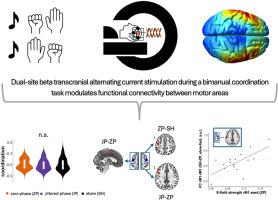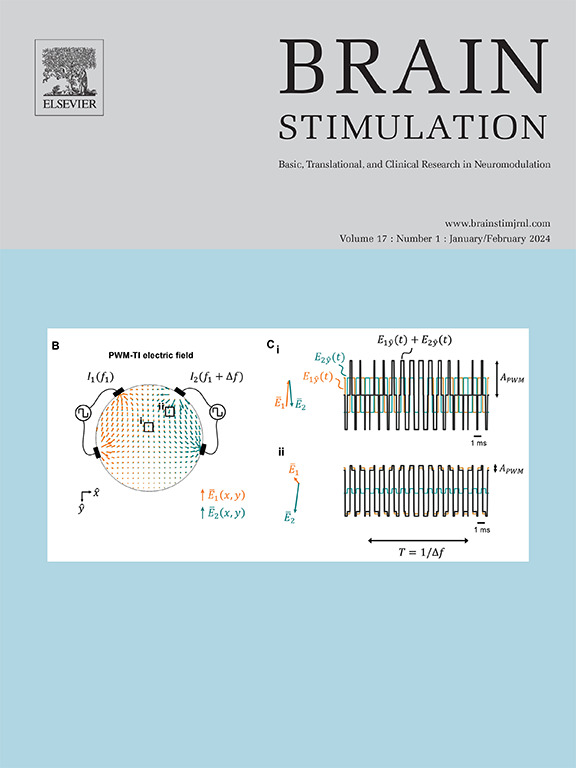双位点经颅交流电刺激在双手协调任务中调节运动区域之间的功能连接
IF 8.4
1区 医学
Q1 CLINICAL NEUROLOGY
引用次数: 0
摘要
大脑网络内部的交流依赖于功能连接。一种很有前景的调节皮质区域之间这种连接的方法是双位点经颅交流电刺激(tACS),它是非侵入性地将弱交流电应用于两个大脑区域。在当前的研究中,我们旨在通过双位点tACS调节双手协调过程中双侧初级运动皮质(M1s)的区域间功能连接,进而改变行为。方法采用功能磁共振成像(fMRI)技术,在并行tACS-fMRI设计中记录参与者在手工协调任务时的大脑反应。在执行慢速和快速版本的任务时,在参与者内部重复测量设计中,参与者在两个M1s上接受三种类型的beta (20 Hz)双点tac:零阶段,抖动阶段或假。结果虽然我们没有观察到任何显著的tACS对行为的影响,但研究揭示了零相位tACS对半球间连通性的衰减效应。此外,两种活跃类型的tACS(零期和抖动期)在与其他运动皮质区域(如运动前皮质和辅助运动区)的任务相关M1连通性方面存在差异。此外,在零相条件下,个体电场强度与功能连通性有关。结论两个m1上的双位点β - tACS改变了运动区域之间的功能连接。然而,在样本量有限的情况下,这种效应并没有显著地转化为行为水平。因此,未来的研究可能会整合机制措施,如半球间抑制措施,以加强因果解释。本文章由计算机程序翻译,如有差异,请以英文原文为准。

Dual-site beta transcranial alternating current stimulation during a bimanual coordination task modulates functional connectivity between motor areas
Background
Communication within brain networks depends on functional connectivity. One promising approach to modulate such connectivity between cortical areas is dual-site transcranial alternating current stimulation (tACS), which non-invasively applies weak alternating currents to two brain areas.
Objectives
In the current study, we aimed to modulate inter-regional functional connectivity with dual-site tACS to bilateral primary motor cortices (M1s) during bimanual coordination and, in turn, alter behaviour.
Methods
Using functional magnetic resonance imaging (fMRI), we recorded participants’ brain responses during a bimanual coordination task in a concurrent tACS-fMRI design. While performing a slow and fast version of the task, participants received one of three types of beta (20 Hz) dual-site tACS over both M1s: zero-phase, jittered-phase or sham, in a within-participant, repeated measures design.
Results
While we did not observe any significant tACS effects on behaviour, the study revealed an attenuation effect of zero-phase tACS on interhemispheric connectivity. Additionally, the two active types of tACS (zero-phase and jittered-phase) differed in the task-related M1 connectivity with other motor cortical regions, such as premotor cortex and supplementary motor area. Furthermore, individual E-field strengths were related to functional connectivity in the zero-phase condition.
Conclusions
Dual-site beta tACS over both M1s altered functional connectivity between motor areas. However, this effect did not translate significantly to the behavioural level in the presence of a restricted sample size. Future studies may thus integrate mechanistic measures, such as measures of interhemispheric inhibition, to strengthen causal interpretations.
求助全文
通过发布文献求助,成功后即可免费获取论文全文。
去求助
来源期刊

Brain Stimulation
医学-临床神经学
CiteScore
13.10
自引率
9.10%
发文量
256
审稿时长
72 days
期刊介绍:
Brain Stimulation publishes on the entire field of brain stimulation, including noninvasive and invasive techniques and technologies that alter brain function through the use of electrical, magnetic, radiowave, or focally targeted pharmacologic stimulation.
Brain Stimulation aims to be the premier journal for publication of original research in the field of neuromodulation. The journal includes: a) Original articles; b) Short Communications; c) Invited and original reviews; d) Technology and methodological perspectives (reviews of new devices, description of new methods, etc.); and e) Letters to the Editor. Special issues of the journal will be considered based on scientific merit.
 求助内容:
求助内容: 应助结果提醒方式:
应助结果提醒方式:


